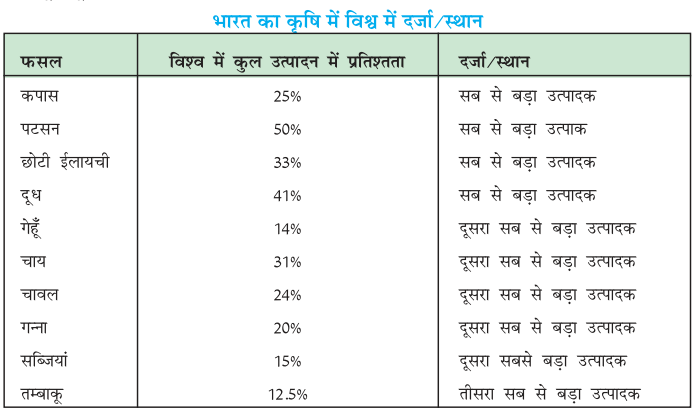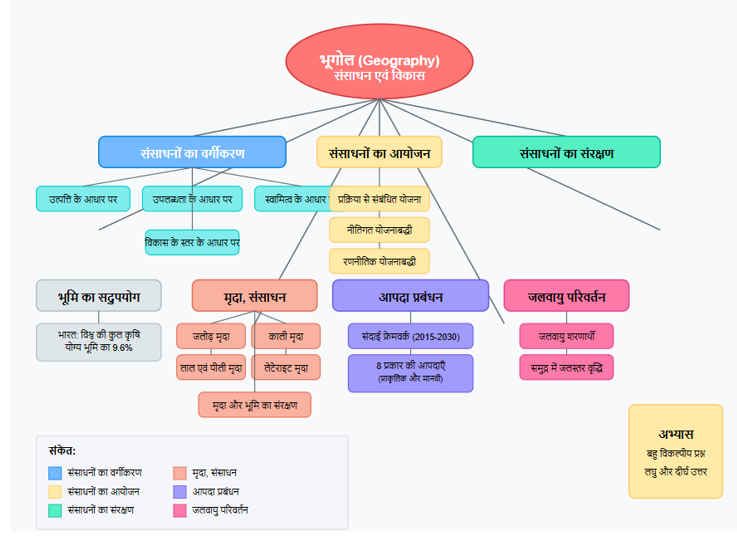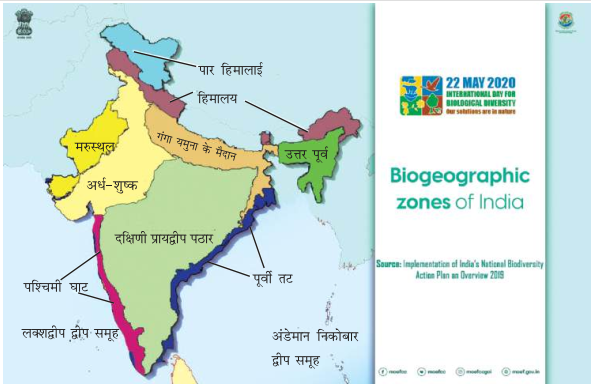1. Multiple-Choice Questions-
(i) Who among the following is considered the father of the Green Revolution?
(a) M.S. Swaminathan
(ii) Agriculture is called ………. economic activity.
(a) Primary
(iii) What percentage of the country’s workforce is employed in the agriculture sector?
(d) 45%
(iv) Which type of agriculture is said to be ancient?
(b) Shifting agriculture
(v) What is meant by HYV seeds?
(a) High Yielding Variety
(vi) Operation Flood is related to what?
(b) Milk production
(vii) What kind of crops are tea, coffee, and tobacco?
(d) Both a and b
(viii) Which is the largest jute producing region in the world?
(d) Sundarbans
(ix) The Terai region is associated with the production of which crop?
(c) Sugarcane production
(x) Match the following:-
-
(i) Paddy, Arhar, Mash/Urad dal – (c) Sawan crops
-
(ii) V. Kurien – (Related to Operation Flood/Milk Production – No direct option)
-
(iii) M.S. Randhawa – (d) Punjab Agricultural University
-
(iv) Bajra, Mustard, Wheat – (b) Hadi crops
2. Answer the following questions in 30 words:-
(i) Which state of India is the ‘spice garden’ and why?
Answer: Kerala is known as the ‘spice garden’ of India. Its warm and humid climate, along with fertile alluvial soil, is ideal for the cultivation of various spices like black pepper, cardamom, cloves, etc.
(ii) Write a brief note on the role of the Agricultural University in the development of agriculture in Punjab.
Answer: The Punjab Agricultural University, Ludhiana, played a pivotal role in increasing grain production and the success of the Green Revolution in Punjab. It promoted agricultural development through advanced seeds, modern farming techniques, and education.
(iii) What is meant by the Global Hunger Index?
Answer: The Global Hunger Index is a tool designed to comprehensively measure and track hunger at global, regional, and national levels. It is based on four indicators: undernourishment, child wasting, child stunting, and child mortality.
(iv) What is the importance of agriculture for us?
Answer: Agriculture is vital for us as it ensures food security, is a major source of livelihood (especially in rural areas), and forms the backbone of the national economy. It also provides raw materials for industries and employment to millions.
(v) Write a note on commercial agriculture.
Answer: In commercial agriculture, crops are primarily grown for sale in the market to earn profit. It often involves modern techniques, large farm sizes, and higher capital investment.
(vi) Write a note regarding Sawan crops.
Answer: Sawan (Kharif) crops are sown at the beginning of the monsoon in June-July and harvested in September-October. Paddy, millets, maize, cotton, and groundnut are major Sawan crops, requiring high moisture and temperature for growth.
(vii) Write any basis for fixing the Minimum Support Price.
Answer: The main bases for fixing the Minimum Support Price (MSP) include the cost of production, demand and supply, domestic and international market prices, and ensuring a remunerative price to farmers.
3. Answer the following questions in up to 250 words:-
(i) Write a detailed note on the types of farming.
Answer: India’s diverse geographical and environmental conditions have led to various types of farming practices. Shifting Agriculture is an ancient form practiced mainly in forest areas, where farmers clear a patch of forest for cultivation for a few years using traditional tools without fertilizers. When soil fertility declines, they move to a new patch. Subsistence Farming involves farmers primarily growing crops for their family’s sustenance, with negligible market surplus, using traditional manures and limited chemical fertilizers. Intensive Farming aims to get maximum yield from small plots through intensive use of high-yielding seeds, fertilizers, pesticides, and irrigation, common in the plains of western and central India. Extensive Farming involves large farm sizes and mechanized operations, with less use of pesticides and chemical fertilizers compared to intensive farming; total production is high, but per-hectare yield might be lower. Commercial Farming has the main objective to sell produce in the market for profit, using modern methods. Crops like tea, coffee, rubber, sugarcane, and spices are grown for the market. Plantation Agriculture is a type of commercial farming where a single crop is grown on a large scale scientifically, primarily for profit. Mixed Farming involves crop cultivation along with animal husbandry. It’s common in densely populated areas, and crop diversification is practiced. Vertical Farming is farming in special conditions using trays or pots with soil-water and high-quality seeds, requiring skilled labor.
(ii) Explain the agricultural seasons in India.
Answer: India primarily has three agricultural seasons. The Kharif (or Sawani) season begins with the southwest monsoon in June-July, with harvesting in September-October. It requires abundant moisture, monsoon rains, and hot, humid weather. Major crops include paddy, arhar, moong, sugarcane, soybean, jowar, bajra, and groundnut. The Rabi season starts with crop sowing in October-November and harvesting from mid-March to April. This winter season is characterized by northeast trade winds, retained soil moisture, and western disturbances bringing light rain beneficial for crops like barley, mustard, wheat, linseed, peas, and gram, which need cool weather for germination and warm weather for ripening. The Zaid season has two short periods. The first is from October to November, between Kharif and Rabi, characterized by retreating monsoon and increasing humidity, suitable for vegetables and fodder. The second Zaid is from mid-March to May, between Rabi and Kharif, featuring mild sunshine and hot, dry weather, also suitable for vegetables, fruits like watermelon, and fodder. This cycle is crucial for India’s food security.
(iii) Write in detail about cotton production in India.
Answer: Cotton is a vital commercial and fiber crop in India, extensively used in the textile industry. India is a leading global cotton producer. Ideal geographical conditions include a temperature range of 20 to 30 degrees Celsius and at least 210 frost-free days. Moderate rainfall (50-100 cm) is suitable, with sunny and dry weather needed during flowering and boll ripening. Black soil (Regur soil), common in the Deccan plateau, is considered best due to its high moisture retention capacity, though it’s also grown in alluvial and laterite soils. India cultivates various staple lengths of cotton. Major producing states include Punjab, Haryana, Rajasthan, Uttar Pradesh, Madhya Pradesh, Gujarat, Maharashtra, Karnataka, Telangana, and Andhra Pradesh, with black soil regions like Maharashtra and Gujarat being particularly famous. Cotton provides livelihood to millions of farmers and generates employment in the textile industry, significantly contributing to India’s exports. Government initiatives support cotton cultivation, though challenges like pesticide overuse and water resource strain require sustainable practices.
(iv) Provide information about the following:
(a) The coffee state of the country
Answer: Karnataka is known as the ‘Coffee House of India’, being the leading coffee-producing state. India produces about 3.5% of the world’s coffee, with Karnataka contributing about two-thirds of this, primarily Robusta and Arabica varieties. The hilly regions of Karnataka’s Western Ghats, especially Chikmagalur, Kodagu (Coorg), and Hassan districts, are famous for coffee. Ideal conditions include temperatures of 15 to 28 degrees Celsius, altitudes of 600 to 1600 meters, annual rainfall of 150 to 250 cm, cultivation under tree shade, and humus-rich, well-drained loamy soil. ‘Cherry Blossom showers’ aid in berry ripening. A significant portion of its high-quality coffee is exported.
(b) India’s tea garden
Answer: Assam is known as ‘India’s Tea Garden’, being the largest tea-producing state, accounting for about 52% of India’s total tea output. The British established large tea plantations here. Assam’s hot and humid climate is highly suitable for the tea bush. Ideal conditions include temperatures of 20° to 30° Celsius, 150 to 300 cm annual rainfall, high humidity, morning dew, and mist. Well-drained, deep, acidic soil rich in humus and iron, often on hilly slopes, is preferred. The Brahmaputra and Surma valleys are major tea-producing regions. Assam tea is world-renowned for its strong liquor and distinct flavor.
(c) Food Security
Answer: Food Security implies ensuring physical and economic access to sufficient, safe, and nutritious food for all people at all times for an active and healthy life. Key aspects include availability (production, stocks, imports), access (economic and physical), and utilization (safe, nutritious food, and nutrient absorption). Globally, population growth and production challenges make securing food difficult. In India, measures like MSP procurement, PDS, and buffer stocks aim to ensure food security. The Global Hunger Index, which ranks countries based on undernourishment and child malnutrition, highlights ongoing food security challenges.
(d) Traditional sugarcane production belt
Answer: India’s traditional sugarcane production belt is primarily in the Terai region, a marshy area at the Himalayan foothills, stretching from west to east across Uttarakhand, Uttar Pradesh, Bihar, and Assam, from the Yamuna to the Brahmaputra River. The region’s hot and humid climate is highly favorable, with temperatures around 20 to 30 degrees Celsius and 100 to 150 cm annual rainfall. Fertile alluvial soil is ideal. Key districts include Haridwar, Udham Singh Nagar, Pilibhit, Lakhimpur Kheri, and parts of Champaran. Uttar Pradesh is the largest sugarcane producer. Winter fog and summer heat can affect yields. Hundreds of sugar mills in this belt are crucial for the local economy.
(v) What is the role of universities in the development of Indian agriculture?
Answer: Agricultural universities have played a crucial and multifaceted role in Indian agricultural development through research, education, and extension services. Research and Innovation: They have developed high-yielding seed varieties (HYVs), disease-resistant strains, and advanced farming techniques. For example, Punjab Agricultural University (PAU), Ludhiana, was central to the Green Revolution’s success. They conduct research on soil health, water management, pest control, and post-harvest management. Education and Human Resource Development: These universities offer degrees in agricultural sciences, veterinary sciences, and related fields, producing trained professionals who disseminate knowledge. Extension Services: They transfer research findings to farmers via ‘Lab to Land’ programs, farmer fairs, demonstrations, and training, encouraging modern farming adoption. Policy Contribution: These institutions provide expert advice to the government for effective agricultural planning. Diversification and Allied Sectors: Universities have contributed to developing horticulture, animal husbandry, fisheries, and agroforestry. The first agricultural university was established in Pant Nagar in 1960, followed by many others, collectively modernizing Indian agriculture and enhancing food production.



